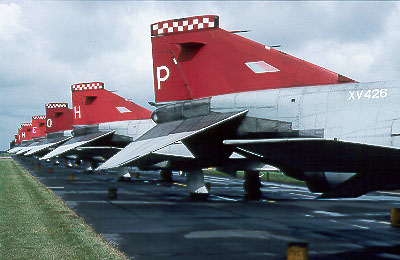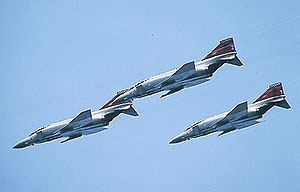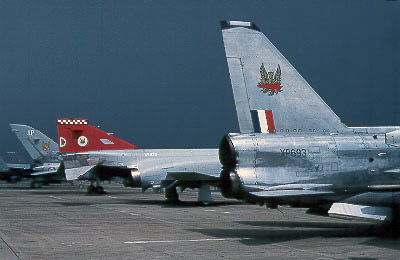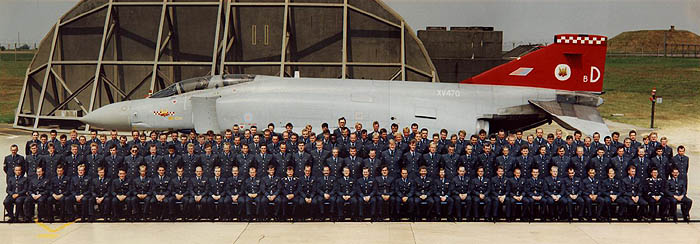![]()

sqncrst.gif) 56 Squadron, otherwise
known as the 'Firebirds' due to the Phoenix rising in the squadron badge,
were residents of Wattisham for quite a while. For some thirty years the
squadron graced the Suffolk skies, only disappearing occasionally for
defence duties at Akrotiri in Cyprus.
56 Squadron, otherwise
known as the 'Firebirds' due to the Phoenix rising in the squadron badge,
were residents of Wattisham for quite a while. For some thirty years the
squadron graced the Suffolk skies, only disappearing occasionally for
defence duties at Akrotiri in Cyprus.
Formed at Gosport on 9 June 1916 from 28 Squadron, the unit had a variety of training aircraft at its disposal, finally receiving SE5as in March the following year. The Western Front beckoned, the squadron seeing extensive action until the end of the Great War. During this time one of the all-time air aces served with the squadron, Captain James T. B. McCudden, earning the first Victoria Cross to be awarded to a pilot of the Royal Air Force. Decorated on 2 April 1918, he was one of the most famous pilots of the First World War, being additionally awarded the DSO and bar, the MC and bar, the Military Medal and the Croix de Guerre. Sadly he was to lose his life in July after being credited with fifty-seven kills to that time.
Disbandment at Bircham Newton followed in January 1920 but exactly eight days later 80 Squadron was re-numbered as 56, operating Sopwith Snipes from Aboukir until another disbandment in September 1922. A month later saw the squadron re-activated for a second time, this time at Hawkinge in Kent, again with the Snipe. Gloster Grebes replaced the Snipes in 1924 and then there was a succession of types, Siskins in 1927, Bulldogs in 1932, Gauntlets in 1936, Gladiators in 1937 and Hurricanes in 1938.
 Commencement of the war saw jittery nerves, September
6 playing host to the 'Battle of Barking Creek'. Six Hurricanes of 56,
now based at Martlesham Heath with deatchments at North Weald, were scrambled
from the latter base to intercept a 'bogey' over West Mersea, together
with Spitfires of 74 Squadron from Hornchurch. In cloudy conditions the
two sets of fighters engaged each other, two Hurricanes being lost. How
ironic, given that the two units would be paired at Wattisham in later
life. Deployed to France in the 'Phoney War', withdrawal to England meant
extensive service in the Battle of Britain, flying from North Weald and
Digby. 'Adler Tag', or Eagle Day, 13 August was particularly busy. On
this day the squadron tackled thirty Me 109s, ten Me 110s as well as some
twenty Ju88s, in the skies over Canterbury. Three Me 110s were destroyed
for the loss of four Hurricanes, as it was an uneven struggle for the
handful of British fighters. Such was the intensity of the Battle that
this kind of action was endured right through to the end of September
when 56 lost five Hurricanes on the last day of the month, fortunately
without the loss of any pilots. A DFC was awarded posthumously to Flt
Lt Percy Weaver on 31 August after 56 had courageously taken on a vast
force of enemy aircraft heading for North Weald; his plane and body have
never been found.
Commencement of the war saw jittery nerves, September
6 playing host to the 'Battle of Barking Creek'. Six Hurricanes of 56,
now based at Martlesham Heath with deatchments at North Weald, were scrambled
from the latter base to intercept a 'bogey' over West Mersea, together
with Spitfires of 74 Squadron from Hornchurch. In cloudy conditions the
two sets of fighters engaged each other, two Hurricanes being lost. How
ironic, given that the two units would be paired at Wattisham in later
life. Deployed to France in the 'Phoney War', withdrawal to England meant
extensive service in the Battle of Britain, flying from North Weald and
Digby. 'Adler Tag', or Eagle Day, 13 August was particularly busy. On
this day the squadron tackled thirty Me 109s, ten Me 110s as well as some
twenty Ju88s, in the skies over Canterbury. Three Me 110s were destroyed
for the loss of four Hurricanes, as it was an uneven struggle for the
handful of British fighters. Such was the intensity of the Battle that
this kind of action was endured right through to the end of September
when 56 lost five Hurricanes on the last day of the month, fortunately
without the loss of any pilots. A DFC was awarded posthumously to Flt
Lt Percy Weaver on 31 August after 56 had courageously taken on a vast
force of enemy aircraft heading for North Weald; his plane and body have
never been found.
A change of role to ground attack in 1941 saw the Hurricanes replaced with Typhoons at Duxford, 56 being one of the first squadrons to operate the type. Operational by June, the squadron participated in supporting the Dieppe landings. Close air support missions were undertaken for the next three years from a variety of bases, including Snailwell in Cambridgeshire and Matlaske in Norfolk, but Spitfires followed in '44, primarily as defence against the V1 threat but later in the photo-reconnaissance role. After D-Day the squadron was supporting the allied advance across France and Belgium, on the move forwards every few days from one base to the next.
 After the war another re-numbering exercise
was implemented, 56 becoming 16 Squadron and 124 becoming 56 on 1 April
1946. This meant Meteor IIIs and a base in Suffolk at Bentwaters, before
the Americans took charge of the base. A brief spell in Essex at Boxted
preceded an initial move to Wattisham in November 1946, but this was a
short-lived affair, only lasting until the following April when a departure
to Duxford was made. Such was the nomadic existence of many squadrons
during these early post-war years. Swifts were received in 1954 at Waterbeach
but swiftly dropped for Meteor F8s in March 1955 and the Hunter a month
later, the lovely Lightning following in January 1961 after a second move
to Wattisham a couple of years earlier. The first Lightning to be received
by the squadron was F1A XM172, arriving on 14 December 1960. This particular
airframe now adorns the gate at RAF Coltishall, although not marked in
56's red and white checks. An undoubted highlight was the 'Firebirds'
display team, the striking red-checked livery never quite matched since.
After the war another re-numbering exercise
was implemented, 56 becoming 16 Squadron and 124 becoming 56 on 1 April
1946. This meant Meteor IIIs and a base in Suffolk at Bentwaters, before
the Americans took charge of the base. A brief spell in Essex at Boxted
preceded an initial move to Wattisham in November 1946, but this was a
short-lived affair, only lasting until the following April when a departure
to Duxford was made. Such was the nomadic existence of many squadrons
during these early post-war years. Swifts were received in 1954 at Waterbeach
but swiftly dropped for Meteor F8s in March 1955 and the Hunter a month
later, the lovely Lightning following in January 1961 after a second move
to Wattisham a couple of years earlier. The first Lightning to be received
by the squadron was F1A XM172, arriving on 14 December 1960. This particular
airframe now adorns the gate at RAF Coltishall, although not marked in
56's red and white checks. An undoubted highlight was the 'Firebirds'
display team, the striking red-checked livery never quite matched since.
 Much of 56's early years with the Lightning
were spent involving air to air refuelling trials, developing the techniques
for the Lightning that would enable the hungry beast to deploy to such
places as Akrotiri and Singapore.
Much of 56's early years with the Lightning
were spent involving air to air refuelling trials, developing the techniques
for the Lightning that would enable the hungry beast to deploy to such
places as Akrotiri and Singapore.
1967 brought a move to sunnier and much warmer climes at Akrotiri, Cyprus but nothing good lasts forever and the squadron returned to Wattisham eight years later. Fifty scrambles were made during the crisis of 1967, without incident and the unit converted to the F6 in 1971 when they took control of the disbanding 74 Squadron fleet from Tengah, Singapore. The coup in 1974 placed the squadron in a delicate situation, 200 sorties being flown to ward off Turkish aggressors. The Defence White Paper of 1975 signified the end of Akrotiri as a fighter base, 56 returning to their Suffolk home by the end of the year.
 29 June 1976 saw the Phantom arrive in 56's
colours at Wattisham, to begin sixteen years of operations in the Suffolk
countryside. Initial line-up comprised XV415/A, XV460/B, XV470/C, XV409/D,
XV486/E, XV489/F, XV475/H, XV420/J and XT891/Z. Most were still in action
during the swansong years of '91 and '92.
29 June 1976 saw the Phantom arrive in 56's
colours at Wattisham, to begin sixteen years of operations in the Suffolk
countryside. Initial line-up comprised XV415/A, XV460/B, XV470/C, XV409/D,
XV486/E, XV489/F, XV475/H, XV420/J and XT891/Z. Most were still in action
during the swansong years of '91 and '92.
56's Firebird now adorns the Tornado F3 interceptor, flying from one of the Phantom's other former homes of RAF Leuchars, Fife, as the official training reserve squadron for the air defence element of the Royal Air Force. The unit is destined to become one of the last operators of the ADV version of the 'Mighty Fin'.
